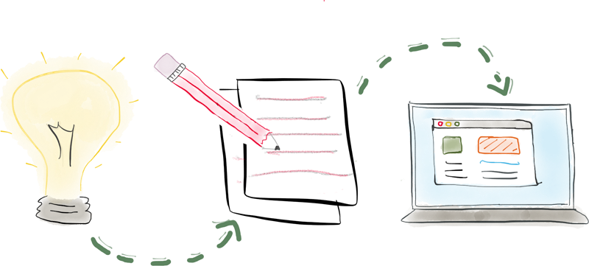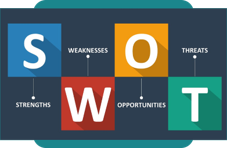What is a project idea – and why does it determine everything?
A successful project doesn’t start with a budget, a partner, or even a funding call. It starts with an idea. Project idea development — a vision of change that the initiator wants to implement in response to a specific problem, challenge, or need. The idea is the heart that drives the entire logic: it defines what needs to be done, who is affected, why it matters, and what the final result should be. A clear idea should encapsulate the goal, target audience, and potential impact.
A strong project idea is always a balance between the desire to make a change and an objective situation that truly requires intervention. It doesn’t emerge in a vacuum. More often, it grows from intersections: between problem analysis, community demands, sector trends, internal team insights, or even personal experience. Therefore, the first step is not to invent something new for novelty’s sake, but to critically examine the situation, ask questions, and see what doesn’t work — or could work better.
In international project cycles — such as Erasmus+, Horizon Europe, or USAID — the idea accompanies the project through every phase: programming, logical framework, proposal development, implementation, monitoring, and evaluation.
In the business world, the journey is similar, although the language differs: generate idea → find funding → develop proposal → submit → award → implement. At every step, a project either survives or fails depending on the strength and viability of its core idea.

How to recognize a strong idea: four criteria for success
To give your idea a real chance at success, it should meet four criteria:
-
Relevance — it must address real, specific needs of your target group
-
Originality — it should not duplicate already implemented projects
-
Innovation — it must bring something new: a method, a tool, an angle, a technology
-
Feasibility — the idea should be realistic given available resources, budget, timeline, and capacity
When developing your idea, ask yourself: What problem do I want to solve, for whom, and why now? If you can logically and clearly answer that, your idea is no longer just a thought — it’s the foundation of your project.
From idea to strategy: how to test and refine your concept
Coming up with an idea is only the first step. Before writing a proposal, you need to test whether your concept has real potential. It should align with market logic, avoid being overloaded with goals, and remain relevant even under likely risks.
Two key tools can help at this stage of project idea development: SWOT analysis and the SMART framework for goal setting. These tools help identify not only ambitions but also realistic boundaries.

SWOT analysis offers four strategic perspectives:
-
S – Strengths: internal advantages, such as experience, skills, market access, or past results
-
W – Weaknesses: internal gaps, like lack of funding, limited capacity, or staff shortages
-
O – Opportunities: external trends or resources that support your effort
-
T – Threats: risks such as inflation, policy changes, or competition
When you fill out a SWOT honestly, you gain a full picture of your situation — where you stand and whether to proceed.
Once your idea has passed this stage of project idea development, it’s time to turn it into goals. This is where SMART comes in:
-
Specific: What exactly will you do?
-
Measurable: How will you track success?
-
Achievable: Can this be done with your current resources?
-
Relevant: Does it align with your needs and strategy?
-
Time-bound: When will it happen?
If your goals meet the SMART standard, they become your compass — guiding your team and assuring funders. Otherwise, it’s best to revisit and clarify your idea.
Why data matters: grounding your idea in evidence
Even a perfectly structured idea won’t work if it lacks a factual foundation. Your justification is where intuition meets evidence. Consequently, every good idea should be based on data — not just assumptions.
Your idea should reflect:
-
a clear problem or challenge
-
supporting data or research
-
a logical structure for action
-
and clear implementation potential
If these elements are present, your idea becomes more than just an abstract vision — it becomes a credible, fundable starting point.
Idea generation techniques: methods that really work
Ideas don’t always arrive on demand. However, there are many tools to help teams generate and refine them.
The most common is brainstorming — a group technique that invites free idea generation without judgment. Usually done in groups of 5–10 people, it requires a moderator and clear timing. All ideas are captured and assessed later.

De Bono’s Six Thinking Hats technique offers six perspectives:
-
White: facts and data
-
Red: emotions and gut feelings
-
Black: critical risks
-
Yellow: positives and benefits
-
Green: creative options
-
Blue: process management
This approach gives a full 360° view and often uncovers hidden angles.
If you already have a basic idea, but want to refine it, use SCAMPER — Substitute, Combine, Adapt, Modify, Put to another use, Eliminate, Reverse.
Synectics is a method for combining unrelated elements to spark new ideas. Based on analogies, it encourages innovative thinking by borrowing insights from other fields.
Freewriting is a solo technique where you write freely on a topic for a set time — usually 10 minutes — without stopping or editing. It unlocks creativity and helps start the ideation process.
Morphological Analysis involves building a matrix of project variables — target group, delivery method, tools, etc. By combining elements, you can discover new approaches.
Mind Mapping is a visual method that starts with a central idea. Around it, you branch out with related terms, ideas, and topics. It’s great for group visioning and project structuring.
Remember: an idea is not just inspiration — it’s a solution. It must address a specific problem, be grounded in data, and be achievable. The deeper you work on your idea at the start, the fewer risks you’ll face later. A strong idea turns a proposal into a project, and a project into real change. Explore more articles on project development, funding, and proposal strategy here: https://getgrant.ua/blog/
